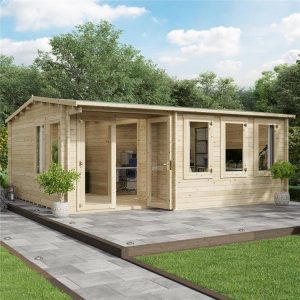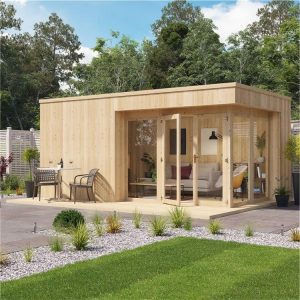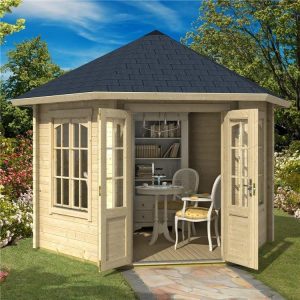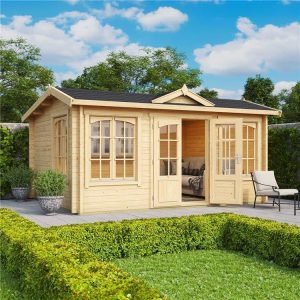If you have a garden, a garden shed is practically a necessity due to the additional space it provides. Beyond just storage, transforming your shed into a functional room can potentially increase your property’s value by up to £22,000.
However, while storage is the most common use, it doesn’t have to be the only one. With a bit of creativity and enthusiasm, your garden shed can become much more than just a place to keep your lawnmower.
This article aims to inspire and motivate you to reimagine your garden shed’s potential. We’ll explore five different ways you can convert your shed into a space for hobbies, work, or relaxation, and we’ll guide you through the steps needed to make these transformations.
And don’t worry – you’ll still have plenty of room left for storage.
Let’s dive in and get started.
Image via Pixabay
Safety First!
Before we dive in, I’d like to take a second to remind you that safety should always come first. The projects we’re going to take a look at each assume that you have at least a basic knowledge of DIY, and for some of the more advanced projects, you may want to consider hiring a professional to help you out.
Be careful when using power tools, and if you plan to hook your shed up to an electricity source, consult a qualified electrician. Seriously. You have been warned.
You should also familiarise yourself with building regulations and planning permission requirements, including by checking out information from the British Standards Institution (BSI) and reading up on the UK government’s National Planning Policy Framework. It is also simple to find out whether you need planning permission for a garden room, office, or log cabin.
With that said, let’s take a look at five garden shed transformation ideas.
#1: From Clutter to Comfort: Create Your Dream Garden Office Shed
Overview: With more and more people working from home or adopting a hybrid model in which they vary between working from home and going to an office, creating a productive and inspiring workspace at home has never been more important.
The great thing about creating a dedicated work zone is that it allows you to separate your work life and your home life. When you’ve finished work for the day, you can leave the shed behind and not have to think about it again until the following day.
Time Investment: Low
Skills Required: Basic DIY, basic interior design, electrical skills or access to a qualified electrician
Cost: Low-Medium
How to:
- Figure out your tech needs: Most home offices will require electricity, unless you plan to rush back to the house every time your laptop starts running out of battery. You’re also going to need a WiFi signal, so consider picking up a signal booster or repeater if needed.
- Include insulation: An insulated garden office is a must for a home office, because without insulation, it’ll get too hot in the summer and too cold in the winter. If that’s the case, you’ll be too uncomfortable to get any work done.
- Focus on ergonomics: By this, we mean that you should optimise your space so that you can work in comfort. Invest in a good quality office chair and make sure that your work surface is comfortable to lean on.
Real-Life Example: Joanna van Blommestein transformed her shed into a bra-fitting boutique called Bra Boss of Kent to provide a supportive and relaxing space for women, especially those who have undergone breast surgery. Her innovative use of the shed earned her the winner’s title in the cabin/summerhouse category of the Cuprinol Shed of the Year competition. (Evening Standard) (Express & Star)
BillyOh Outpost Insulated Garden Room
#2: From Mess to Masterpiece: Welcome to Your New Garden Room Art Studio
Overview: If you’re creative, you can take your shed and turn it into a garden room for you to practise and display your art in. The great thing about this concept is that you can make it work for any art form, whether you’re a painter, a sculptor, or a potter.
Turning your shed into an art studio is probably the easiest of all of the options we’re going to take a look at. All you need to do is to take an existing shed or to build a new one, then empty it all out and move your equipment inside. But of course, as an artist, you’re also going to want to spend some time making it look good.
Time Investment: Low
Skills Required: Basic DIY, intermediate interior design
Cost: Low
How to:
- Prioritise natural light: As an artist, natural light is your best friend. Without it, it becomes a lot harder to get the colours right in your artwork, and that’s without the natural benefits that come from spending time in natural light and away from artificial light sources.
- Identify storage solutions: Most of the artists that I know have a ton of materials, from paints and brushes to canvasses, pastels, art books and more. That means that if they want to have any chance of finding things in their studio, they need to think about storage. There needs to be a place for everything and everything in its place.
- Make the most of your space: For most people, even a small shed can serve as an art studio. The key is to make the most of your space by keeping things as tidy and organised as possible. Where possible, use natural light by picking a shed with big windows, and you can also make your space seem bigger by using mirrors.
Real Life Example: Emily, an artist, transformed her shed into a vibrant art studio. She painted the walls in bold colours and hung her artwork, creating the perfect creative retreat. This innovative space allowed her to explore her creativity in a dedicated environment tailored to her needs. For more details, you can visit the original sources here and here (Michelle Farro) (artistintheshed
BillyOh Dojo E Insulated Building
#3: From Rubbish to Retreat: Craft a Cosy Garden Building Summer House
Overview: Your garden shed doesn’t need to be a functional space where you get things done, like in our last two examples. In fact, the best option is often to take your shed and turn it into a summerhouse that you can relax in.
Summer houses allow you to unlock a whole bunch of benefits, from the fact that they can increase your usable space and improve the value of your house to the fact that they’re great for hosting parties and barbecues. And let’s not forget that there are a number of benefits to be had from connecting with nature in a garden retreat shed or log cabin.
Time Investment: Medium
Skills Required: Intermediate DIY, intermediate interior design, electrical skills or access to a qualified electrician
Cost: Medium
How to:
- Start with utility: If you’re turning your shed into a retreat then you’re going to need to supply it with electricity, and you may even want to work with a plumber to hook it up with a sink or a bathroom, depending upon how big it is.
- Make it peaceful: After you plan the initial layout with your utilities in mind, you can move on to the look and feel of the retreat. This is where you’re going to focus on incorporating calming décor and making the retreat as homely as possible.
- Make it comfortable: Now that your outdoor haven is hooked up with the utilities it needs and is decorated appropriately, the next step is to invest in some comfortable furniture. Go back to utility and think about how you plan to use the room, then purchase the furniture accordingly.
Real-Life Example: Rosie Hoult and her husband, David, transformed their shed into an idyllic bird-watching sanctuary decorated in a Moroccan theme during the lockdown. This project, named “The Hideaway,” evolved from a simple idea of creating a bird table into a full-fledged sanctuary. The Moroccan-inspired design brought a touch of exotic charm to their garden, and the project significantly strengthened their bond, providing a peaceful retreat for relaxation and bird-watching. Their creative shed won the Nature’s Haven category in the Cuprinol Shed of the Year 2021 competition (Shropshire Star) (Shropshire Star) (ShedBlog #shedoftheyear 2024) (Goodhomes Magazine).
Natura Elysian Hexagonal Summerhouse
#4: From Storage to Studio: Make a Musical Summer House Masterpiece
Overview: If you’re a musician then the chances are that you’ve always dreamed of having a recording studio of your own. A summerhouse in your back garden provides you with the perfect opportunity to finally have one.
A summerhouse music studio provides you with much more than just a dedicated space for practising and recording music. It gives you a place where you can enjoy some alone time and means that you won’t have to deal with take after take being ruined by noisy pets, kids or partners.
Time Investment: High
Skills Required: Intermediate DIY, basic interior design, electrical skills or access to a qualified electrician
Cost: High
How to:
- Soundproof early: Soundproofing is vital for every good music studio, and it’s especially important when it’s out in your back garden. You can find some basic soundproofing kit online, but if you plan to use your studio a lot or to have full band practices out there, you might want to bring in a professional.
- Think about electricity: Electricity is a must for most of the garden shed designs we’re talking about, but it’s arguably most important for a music studio. You’ll need it to power your amps and your recording gear, but you’ll also want install an alarm and some security cameras.
- Use the remainder of your budget to buy gear: The mistake that most people make is that they spend all of their money on music gear and have nothing left over for the renovation. Avoid this problem by doing the renovation first and using whatever you have left to buy the gear.
Real-Life Example: Les Rowe created “Tranquility Base,” a unique seven-sided shed featuring stained glass windows and a domed roof, using materials mostly donated by family, friends, and neighbours. This artistic haven won the Budget category in the Shed of the Year competition (Goodhomes Magazine).
Natura Solstice Log Cabin Summerhouse
Shed #5: From Garden to Guest House: Make Your Own Airbnb
Overview: Create an insulated garden room that’s designed to host guests overnight and to allow them to be totally self-sufficient. You might do this so you can have friends and family to stay over, or you might want to make a little cash by building a log cabin and renting it out on Airbnb.
The great thing about this approach is that while it can be expensive to build out your guest house, you can make all of that money back over time. That’s important because with all of the insulation, plumbing, and furniture costs, building a guest house is often just as expensive as building a state-of-the-art recording studio.
Time Investment: High
Skills Required: Advanced DIY, advanced interior design, electrical skills or access to a qualified electrician, plumbing skills or access to a plumber
Cost: High
How to:
- Make it well-insulated: When you’re building a guest house, you need to make sure that it’s built to the same standards that you’d expect from your primary property. This starts with the insulation, and you’ll want to get a professional to help if you plan to have people staying over. Or you can get a pre-insulated garden room.
- Think about plumbing and electricity: Without running water and electrical sockets, your guest house won’t be welcoming any guests. If you plan to rent it out as an Airbnb, you’re also going to need a bathroom with a shower, so be sure to shop around to find decent plumbers and electricians who can help you out.
- Make it comfortable: When you’re welcoming guests to your property, you need to make them feel as comfortable and as welcome as possible. Put comfort first and invest in decent furniture like a quality bed and mattress and a comfortable sofa.
Conclusion
Garden sheds are a fundamental part of British culture in a way that our friends overseas often struggle to understand. There’s even an organisation called the Men’s Sheds Association which aims to encourage people to “come together to make, repair and repurpose, supporting projects in their local communities [and] improving wellbeing, reducing loneliness and combating social isolation.”
The garden shed transformation ideas we’ve shared today are exactly what you need to turn your shed into the latest in a long line of incredible sheds that have changed people’s lives for the better. Who knows? Perhaps you’ll end up winning Shed of the Year and becoming a fully-fledged “sheddie”.
Now that you know the options that are out there, it’s time for you to decide which garden shed renovation project you’re going to go for and to start reading up on it. The information we’ve shared today should be enough to get you started, but don’t be afraid to take these ideas and to make them your own.
Oh, and be sure to come back and let us know how you get on or if you need any help. We’d love to hear from you.







